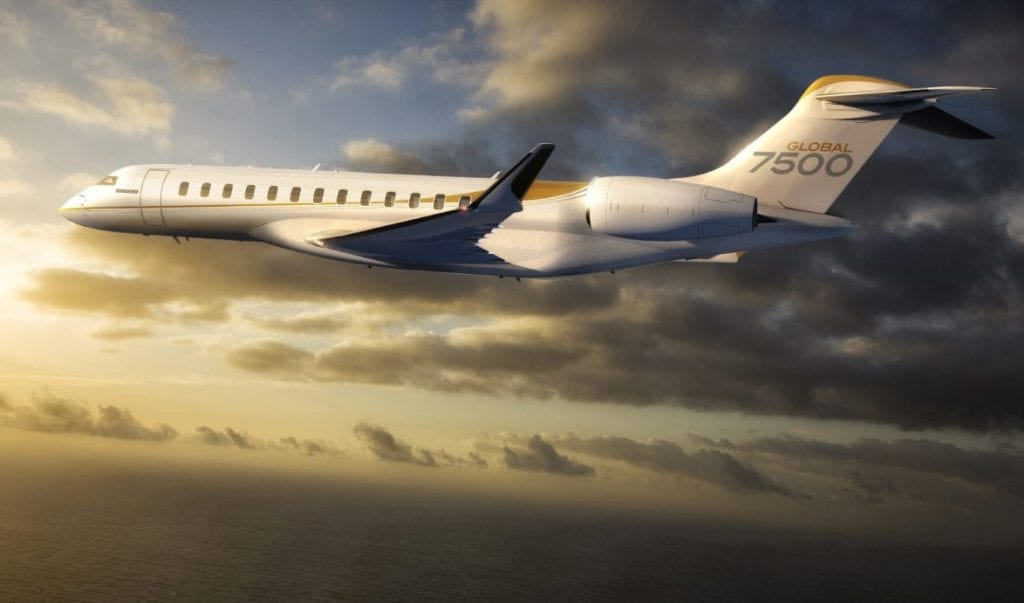
The Bombardier/GE Aviation Smart Link Plus health monitoring unit is to be offered as a free upgrade for 2,500 Bombardier Challenger and Global business jets, such as the Global 7500. Photo: Bombardier
The Smart Link Plus health monitoring unit that Bombardier Aviation and GE Aviation are working to roll out later this year is to customize the release of data to the needs of a broad swathe of aircraft personnel.
Bombardier and GE Aviation are to offer Smart Link Plus as a free upgrade to 2,500 Bombardier Challenger and Global business jets, the companies announced last October at the 2019 National Business Aviation Association annual conference and exhibition.
Smart Link Plus is to feature Avionica’s onboard network system, aviONS, installed in the electric equipment bay of Challenger and Global jets. Avionica’s aviONS technology features a remote data concentrator, an airborne data loader, and a quick access recorder and cabin/flight deck server with up to one terabyte of storage. A product description of aviONS also notes a 4G gateway and the ability to capture ARINC 429 and 717 data as well as an ARINC 759 aircraft interface device. The box also is to include full duplex-switched Ethernet and removable SD cards.
“This [Smart Link Plus] will be the first time that we’ll have the ability to have these at-base applications where customers, operators, pilots and directors of maintenance can choose how they want the data presented and formatted, and then we can allow for a whole new product and service offering that’s never been done before,” Bombardier Aviation President David Coleal told Avionics International in a brief interview this week after a round table discussion in Washington, D.C. on the new General Aviation Manufacturers Association State of the Industry 2020 report.
The report suggests that the business jet market is on an upswing. Last year saw the delivery of 809 business jets – the highest annual figure since 2009 and an increase from the 703 business jets delivered in 2018.
The business jet market is the sole focus of Bombardier Inc., as the company said this month that it is selling off its rail business to Alstom SA and exiting the commercial aircraft industry by selling Bombardier’s remaining stake in the A220 airliner to Airbus Canada for $591 million.
Bombardier Aviation has other business jet avionics developments beside Smart Link Plus, including the Federal Aviation Administration (FAA) approval last month of an upgrade to the Garmin G5000 avionics suite as a retrofit for Learjet 70s and 75s and as a feature of Learjet Liberty 75 jets expected to enter service by the middle of this year.
The upgraded Garmin G5000 will bring workload-reducing improvements, including climb, cruise and descent vertical navigation, and enhanced take-off and landing performance calculations, according to Bombardier. In addition, the company said that it is offering, as an option, FANS [Future Air Navigation System] 1/A+, “which enables access to the most efficient and favorable routes. FANS 1/A+ “will ensure readiness for modernized airspace requirements and deliver efficiency gains that are expected to lower direct operating costs,” Bombardier said. “Pilots will also benefit from a vast array of wireless connectivity features, including two-way flight plan transfers between compatible apps and avionics, available thanks to Garmin’s Flight Stream 510 solution.”
Bombardier Aviation has also been working with Thales and StandardAero on a possible FAA certification this year of the Thales TopMax wearable head-up display for the Bombardier Challenger 350 in what would mark the first wearable HUD certification for business jets.
In addition, Bombardier Aviation expects the certification of the Combined Vision System (CVS) for the company’s Global 5500 and 6500 business jets soon.
The Federal Aviation Administration certified the Global 5500 and 6500, equipped with the Bombardier Vision Flight Deck and the Collins Aerospace Pro Line Fusion avionics suite, in December. Over the last two years, Bombardier and Collins Aerospace have also been developing CVS for the jets – a system that Coleal said will be the “first true combined vision system” developed solely for business jets.
CVS is to merge infrared enhanced vision system (EVS) and synthetic vision system (SVS) imagery into a single conformal view to increase safety and reduce pilot workload formerly required by toggling between EVS and SVS.
“The fusion of those two technologies is going to be amazing, the first in the industry,” Coleal said.